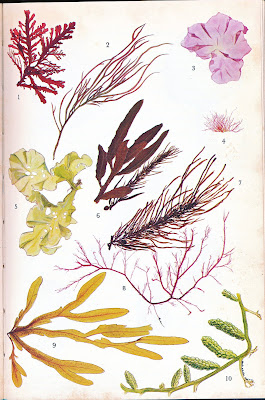 Edible Algae, Seaweeds of Australia: Sea grapes, Sea lettuce and Sea-string.
Edible Algae, Seaweeds of Australia: Sea grapes, Sea lettuce and Sea-string.
The sea can be cruel. It is shocking to see the devastation caused by the earthquake and resulting tsunami in Japan. The unfolding story is revealing total destruction of communities who live close to and derive their livelihood from the ocean. Large areas of their coast are set aside for the cultivation of seaweed which is an important food plant and essential part of the diet of the people. I often buy seaweed salad, imported from Japan, and it is delicious to eat. I am also familiar with wakame, nori, and kombu. Kombu (Laminaria japonica) is boiled with katsuobushi (Bonito flakes) to make dashi, a stock essential in Japanese cuisine.
In Australia there has been very little use of our native seaweeds in the food industry. During colonial times ladies made milk jellies from species such as Eucheuma speciosum of Western Australia and later this was used in the meat canning industry during the second World War when imports were restricted.The giant brown alga, Macrocystis pyrifera from Tasmania's east coast has also been used for the extraction of sodium alginate which is used as a stabilizing agent in foodstuffs such as icecream. Sea grapes, Caulerpa racemosa, which I often come across when exploring tidal rock pools, is easy to identify by the creeping stem with bulbous 'grapes' attached. It is cultivated in the Philippines for use as a popular salad vegetable mixed with tomato and onion and dressed with vinegar. Sea lettuce (Ulva lactuca) is another type which you may come across on rocky shores at low tide. The plants appear as green sheets about 15cm long and can be eaten raw in salads or added to soups. Sea string (Gracilaria species) is sometimes called Chinese Moss as this plant is used in China for a special dish celebrating New Year. It is found in bays and estuaries and consists of cylindrical or flattened stems up to 2 metres in length. It can be eaten raw or boiled but also can be dried for later use to make milk jellies. After washing in fresh water to remove any marine animals it can be dried in the sun for a week or so with constant turning.
The image of seaweed for use only as a garden fertilizer needs to change but it will take a celebrity chef with an eye for the unusual to create an interest in it and for it to become part of our diet as in Japan.
The image of seaweed for use only as a garden fertilizer needs to change but it will take a celebrity chef with an eye for the unusual to create an interest in it and for it to become part of our diet as in Japan.
So they have not only lost rice fields, but also access to harvesting sea vegetables? It is so frightening to see what is happening in Japan.
ReplyDeleteInteresting post on different sea weeds. Living far from the sea, we don't use sea weed in our diet, but fisherfolk in the west coast use them regularly.
ReplyDelete